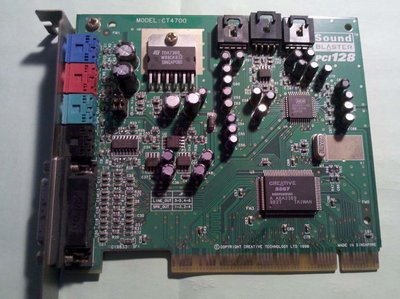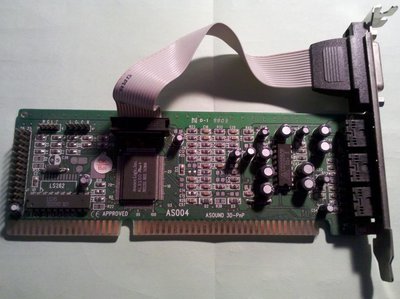Further investigations. This archived Usenet thread from 1997 (if you can ignore the flamewar!) confirms: practically everything about the AudioPCI is really handled by the host PC. Think WinModems, for the sound card world. The whole thing boils down to a 2xDAC 1xADC on a PCI card with an AC'97 codec, UART/gameport, and a handful of other features.
https://groups.google.com/forum/#!searchin/co … w8/YFt4ipE97kEJ
This provides a new understanding of the Legacy (SB / AdLib / MT-32 / etc emulation) block on the chip. It is designed to respond to events on the specified ports, but merely forwards back to the driver whatever the request was. Better than a TSR, it seems, because it's implemented on the PCI bus directly and looks just like real hardware to whatever program is calling it. The driver contains a MIDI softsynth which handles MT-32 (and AdLib...?), shunting the raw PCM stream to the output mixer along with any other PCM data (SB, WSS, etc).
Further thoughts follow...
In this regard, then, the ALSA driver for es1370 / 1371 is actually rather feature-complete. Only a few more card features remain untapped in the driver code:
* More granular power-saving features (certain items - Joystick, UART, serial, PCI crystal, AC'97 CODEC - can be turned off individually to conserve energy). The current driver appears to support only shutting down the AC'97 chip when going into suspend mode.
* Legacy block support (but this would serve absolutely no purpose, because no sane *nix app would directly bang the SB IO ports instead of talking to /dev/sequencer or whatever)
What about that MIDI softsynth, and the ecw files? Fortunately, someone has already reverse-engineered the format and pulled out the data. Unfortunately, it does not exactly fit into SF2 soundfont format and some data is lost in the conversion. One interesting project might be to find a suitable container which is supported by TiMidity (or comparable existing softsynth), and unpack the various samples there, which would bring us full-circle to emulating AudioPCI MIDI sound in any modern OS.
Where does that leave DOS users? The Legacy block forwards requests back to the driver. A new community driver could conceivably be developed, which brings in all the nice tech of the last X years... things like a *real* OPL-3 emulator from AdPlug, a better MIDI softsynth or a more configurable one (route MIDI out the joystick port instead), etc etc. These cards could thus conceivably become some of the best DOS soundcards, if the CPU was up to scratch to actually do the sound processing, because 48khz quadraphonic sound with a 90dB noise floor in a ubiquitous PnP PCI form factor is not a bad platform to start from...

